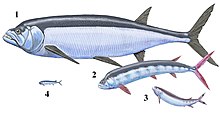| Ichthyodectiformes Temporal range:
| |
|---|---|

| |
| Scientific classification | |
| Domain: | Eukaryota |
| Kingdom: | Animalia |
| Phylum: | Chordata |
| Class: | Actinopterygii |
| Division: | Teleostei |
| Order: | †Ichthyodectiformes Bardack & Sprinkle, 1969 |
| Subgroups | |
|
See text | |
Ichthyodectiformes is an extinct order of marine stem-teleost ray-finned fish. The order is named after the genus Ichthyodectes, established by Edward Drinker Cope in 1870. Ichthyodectiforms are usually considered to be some of the closest relatives of the teleost crown group.[1]
They were most diverse throughout the Cretaceous period, though basal forms like Thrissops, Occithrissops and Allothrissops are known from the Middle-Late Jurassic of Europe and North America. They were almost entirely wiped out by the Cretaceous-Paleogene extinction event, but a single species, Saurocephalus lanciformis, appears to have survived into the earliest Paleocene (Danian).[2]
Most ichthyodectiforms ranged between 1 and 5 meters (3–15 ft) in length. Most of known taxa were predators, feeding on smaller fish; in several cases, larger ichthyodectiforms preyed on smaller members of the order. Some species had remarkably large teeth, though others, such as Gillicus arcuatus, had small ones and sucked in their prey. Heckelichthys preopercularis is a rare example of non-predatory ichthyodectiform, more likely to be microphagous, fed on small particles.[3] There is evidence that at least one species, Xiphactinus audax, may have been endothermic ("warm-blooded").[4] Another genus, Dugaldia, may have been able to laterally open its mouth extremely wide in a manner akin to the modern sarcastic fringehead.[5]
- ^ Nelson, Joseph S.; Grande, Terry C.; Wilson, Mark V. H. (2016). Fishes of the World (5th ed.). John Wiley & Sons. ISBN 9781118342336.
- ^ Boles, Zachary; Ullmann, Paul; Putnam, Ian; Ford, Mariele; Deckhut, Joseph (2024). "New vertebrate microfossils expand the chondrichthyan and actinopterygian fauna of the Maastrichtian–Danian Hornerstown Formation in New Jersey". Acta Palaeontologica Polonica. 69. doi:10.4202/app.01117.2023. ISSN 0567-7920.
- ^ Baños-Rodríguez, Rocio Elizabeth; González-Rodríguez, Katia Adriana; Wilson, Mark V. H.; González-Martínez, Jorge Alberto (2020-06-01). "A new species of Heckelichthys from the Muhi Quarry (Albian–Cenomanian) of central Mexico". Cretaceous Research. 110: 104415. Bibcode:2020CrRes.11004415B. doi:10.1016/j.cretres.2020.104415. ISSN 0195-6671. S2CID 213275574.
- ^ Ferrón, H. G. (2019). "Evidence of endothermy in the extinct macropredatory osteichthyan Xiphactinus audax (Teleostei, Ichthyodectiformes)". Journal of Vertebrate Paleontology. 39 (6): e1724123. Bibcode:2019JVPal..39E4123F. doi:10.1080/02724634.2019.1724123. hdl:1983/e6d12da6-4f25-46ce-bb14-74fd2beddd82. S2CID 216158318.
- ^ Cavin, Lionel; Berrell, Rodney W. (2019-01-02). "Revision of Dugaldia emmilta (Teleostei, Ichthyodectiformes) from the Toolebuc Formation, Albian of Australia, with comments on the jaw mechanics". Journal of Vertebrate Paleontology. 39 (1): e1576049. doi:10.1080/02724634.2019.1576049. ISSN 0272-4634.